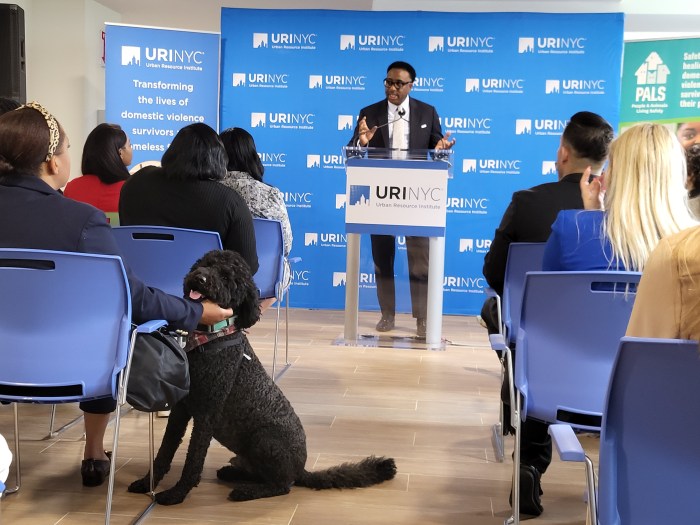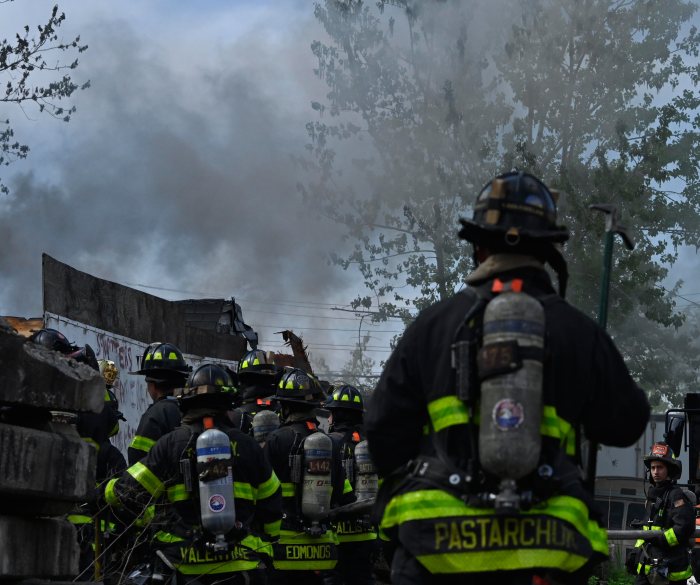By Julie Shapiro
The Port Authority has a new plan to rebuild ground zero and a new office to coordinate it — but the community’s quality of life concerns remain the same.
The new plan came from Chris Ward, the Port’s executive director, whom Gov. David Paterson appointed last spring. Ward has appeared twice before Community Board 1, a show of openness that drew the community’s support even as Ward was unable to solve many of their construction-related problems. Led by Quentin Brathwaite, the new office is the Office of Program Logistics, which Ward created to combine construction coordination with community outreach.
But the Port’s focus on the community doesn’t mean the community will always win.
“There may be times when the needs of the site exceed the capacity to address community concerns,” Ward told City Councilmember Alan Gerson during a hearing Monday.
Ward’s comments came several days after he released a report on the W.T.C. site that shows $1.5 billion in cost overruns and puts several major projects behind schedule. Ward presented the report to C.B. 1 Monday night and addressed the community’s quality of life concerns, including disruptive construction noise, the likely closure of a block of Vesey St. and service outages on the No. 1 subway and PATH trains.
Several residents complained that the noise from the site starts with truck backup alarms beeping before 6 a.m. and ends with jackhammering past 11 at night.
“It’s killing us. It’s killing us,” said Pat Moore, who lives across from the site at 125 Cedar St. “You just can’t get any sleep.”
Bill Love, a C.B. 1 member who lives in Gateway Plaza, reminded the Port of its previous agreement to try to restrict work between 11 p.m. and 7 a.m.
“I can’t state unequivocally…that we can restrict all construction at all times within those hours,” Ward told C.B. 1’s W.T.C. Redevelopment Committee.
Ward added that he would look into moving noisy work into the daytime rather than early in the morning and late at night, but he said he could make no promises.
“The schedule needs to be the efficient schedule,” Ward said.
That may not be precisely what the community wants to hear, but “at least it’s more realistic,” said Julie Menin, chairperson of C.B. 1, after the meeting. “Before what we got were a lot of different platitudes about what was happening, which turned out not to be the case. By leveling with the community, [at least] people can plan…. Of course it’s frustrating to not get exactly what the community needs, but at least we’re getting more responsiveness than before.”
At the C.B. 1 meeting, Glenn Guzi, a program manager for the Port Authority, added that the Port has set aside several million dollars for soundproof windows in buildings facing the site. However, it is up to the individual building owners to install the windows, and Samson Management, the owner of Moore’s building, has not installed the windows.
“It is time for the government to step up and speak to those management offices and insist,” Ward said.
Because of the pervasive noise and other inconveniences Moore has faced, she and several other residents were angry to hear about the subway outages announced last week. The 1 train will terminate at Chambers St. for six weeks in the summer of 2010 and possibly some of 2009, and the PATH trains will shut down on 40 out of 52 weekends starting next summer. Moore was particularly offended by the way Gov. Paterson described the impact of the outages on Lower Manhattan residents and commuters.
“As much as it will be a sacrifice for them, I hope that they will also see it as a contribution they are making to the memorial coming in on time,” Paterson said during a press conference last week. “And if we didn’t think the memorial could come in on time, we wouldn’t ask them.”
Moore called the governor’s comments flip, cavalier and insensitive.
“How dare he say that?” Moore asked. “Haven’t we made enough contributions already? What are we getting out of this? We’re getting all the inconveniences and all the noise.”
Andy Jurinko, Moore’s husband, said those who live near the site have been making sacrifices for seven years, including the several years where they lost their homes.
Another sacrifice the community will likely have to make is the closure of Vesey St. between Church and W. Broadway. Silverstein Properties would use that block of Vesey St. to stage the construction of Tower 2.
“The contractor would like nothing better than to shut it down within the next few weeks,” said Sam Schwartz, the Port’s newly hired traffic coordinator with the Program Logistics Office.
Schwartz, better known in traffic circles as “Gridlock Sam,” likened Lower Manhattan’s streets to an obstacle course and said he would do everything he could to keep Vesey St. open. But the Port has already widened the sidewalks on blocks of Barclay St. and W. Broadway, in preparation for Vesey St.’s closure.
The community wants Vesey St. to stay open because it is a key east-west thoroughfare connecting Battery Park City to the Financial District. Many pedestrians who used to traverse the W.T.C. use the Vesey St. bridge to cross West St., and while the bridge will not be affected, pedestrians will have to go several more blocks out of their way in order to use it. Vesey, site of the temporary PATH entrance, can see 15,000 pedestrians an hour and 150,000 to 200,000 pedestrians a day, according to the Port.
Around the middle of next year, pedestrians will also have to contend with changes to the Liberty St., bridge, which will land one block south on Cedar St. instead. The sidewalk on the west side of Church St. is also closed and will likely stay closed for the duration of the W.T.C. rebuilding, though the Port plans to add artwork to the construction fence showing how the site will eventually look.
At the community board meeting, Brathwaite, head of the Program Logistics Office, started several sentences with the phrase “When Vesey St. is closed,” though he quickly corrected that to “If and when.” Brathwaite, who had been assistant director of World Trade Center construction until his promotion, promised not to close Vesey St. without meeting with the community board first, which means that the street will stay open at least until next month.
“Safety is paramount,” Schwartz said. “It cannot be kept open if it is not safe.”
The community’s quality of life issues are likely to grow as work at the site ramps up — the work will peak in 2011 and 2012 with more than six times more manpower on the site than there is now.
Schwartz plans to hold “walkshops” on the streets around the site so residents can show him the problems they see. He also promised to tackle illegal vendors and placard parking around the site and to figure out a plan for the hundreds of additional tour buses that will inundate Lower Manhattan once the memorial is open.
“There’s no issue too big, and certainly no issue too little for us,” Schwartz told C.B. 1.
Menin, C.B. 1’s chairperson, called the Office of Program Logistics a step in the right direction.
“Someone will be able to deal with many of the logistical issues that have stymied and frustrated the process,” she said. “I’m encouraged overall by the level of answers we’re finally starting to see.”


















